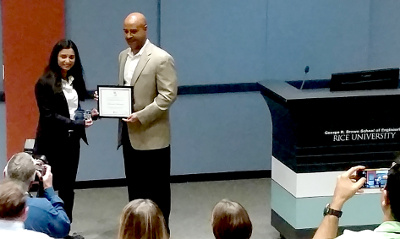 Sharmila Shirodkar, a postdoctoral research associate in Yakobson’s Group, is the recipients of the 2018 Outstanding Postdoctoral Research Award of Rice University’s George R. Brown School of Engineering.
Sharmila Shirodkar, a postdoctoral research associate in Yakobson’s Group, is the recipients of the 2018 Outstanding Postdoctoral Research Award of Rice University’s George R. Brown School of Engineering.
Sharmila’s research focuses on the electronic and plasmonic properties of 2D materials using first-principles calculations. Her recent work involved exploring plasmonic response of recently discovered 2D sheets of boron, and determining the stability of these sheets with doping via atypical simulation technique. She also works on the optical properties of 2D materials, and tinkers on finding new combinations of nano-catalysts for enhanced hydrogen evolution reactions.
Sharmila finished her Ph.D. from the Theoretical Sciences Unit in JNCASR, Bangalore, India in 2014. She was a postdoc at the John A. Paulson’s School of Engineering and Applied Sciences, at Harvard University from 2015 to 2016 before joining Prof. Yakobson’s group in the Material Science and NanoEngineering department at Rice University in 2016.

